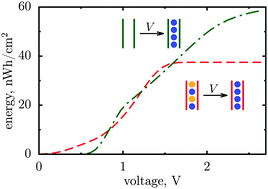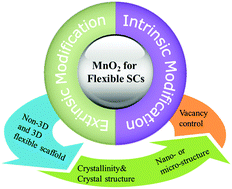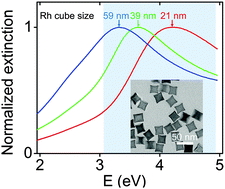The Nanoscale Horizons Editorial Office are delighted to announce the first ever articles have been published online as Advance Articles in preparation for the first issue scheduled to be published in January 2016.
Links to the first articles are below and are free to access until 2017. If you would like to keep up-to-date with cutting edge nanoscience research, sign up to the table of contents alerts here.
| Three dimensional nitrogen-doped graphene hydrogels with in situ deposited cobalt phosphate nanoclusters for efficient oxygen evolution in a neutral electrolyte Anthony Vasileff, Sheng Chen and Shi Zhang Qiao |

A hybrid electrode of cobalt phosphate (CoPi) on nitrogen doped graphene hydrogels was fabricated by hydrothermal treatment of graphene oxide followed by CoPi electrodeposited in situ, which showed excellent performance toward oxygen reaction in a neutral electrolyte. Nanoscale Horiz., 2016, DOI: 10.1039/C5NH00002E
|
| Pressing a spring: what does it take to maximize the energy storage in nanoporous supercapacitors? Svyatoslav Kondrat and Alexei A. Kornyshev |
 We discuss the nonlinear effects and efficiency of charge storage in supercapacitors with nanoporous electrodes and ionic liquids, and demonstrate that to maximize the stored energy, it may be beneficial to create ‘obstacles’ or ‘difficulties’ in charging. This can be achieved by making thermodynamically unfavourable conditions for ions inside nanopores, or more favourable outside. We show by means of Monte Carlo simulations that such ‘ionophobic’ pores store energy more efficiently and can provide equivalent or even better energy capacity. Since the recent analysis predicts much faster charging of ionophobic nanopores, we conclude that such pores offer a better option for simultaneous energy/power optimization. We discuss the nonlinear effects and efficiency of charge storage in supercapacitors with nanoporous electrodes and ionic liquids, and demonstrate that to maximize the stored energy, it may be beneficial to create ‘obstacles’ or ‘difficulties’ in charging. This can be achieved by making thermodynamically unfavourable conditions for ions inside nanopores, or more favourable outside. We show by means of Monte Carlo simulations that such ‘ionophobic’ pores store energy more efficiently and can provide equivalent or even better energy capacity. Since the recent analysis predicts much faster charging of ionophobic nanopores, we conclude that such pores offer a better option for simultaneous energy/power optimization.
Nanoscale Horiz.,2016, DOI: 10.1039/C5NH00004A |
| Nanoscale adhesion forces between the fungal pathogen Candida albicans and macrophages Sofiane El-Kirat-Chatel and Yves F. Dufrêne |

The development of fungal infections is tightly controlled by the interaction of fungal pathogens with host immune cells. While the recognition of specific fungal cell wall components by immune receptors has been widely investigated, the molecular forces involved are not known. In this Communication, we show the ability of single-cell force spectroscopy to quantify the specific adhesion forces between the fungal pathogen Candida albicans and macrophages. The Candida–macrophage adhesion force is strong, up to ∼3000 pN, and corresponds to multiple cumulative bonds between lectin receptors expressed on the macrophage membrane and mannan carbohydrates on the fungal cell surface. Adhesion force signatures show constant force plateaus, up to >100 μm long, reflecting the extraction of elongated tethers from the macrophage membrane, a phenomenon which may increase the duration of intercellular adhesion. Adhesion strengthens with time, suggesting that the macrophage membrane engulfs the pathogen quickly after initial contact, leading to its internalization. The force nanoscopy method developed here holds great promise for understanding and controlling the early stages of microbe–immune interactions. Nanoscale Horiz., 2016, DOI: 10.1039/C5NH00049A |
| Magnetically tunable colloidal micromirrors James Goebl, Yiding Liu, Sandy Wong, Serkan Zorba and Yadong Yin |

Herein we demonstrate a method for decorating highly reflective 2D gold microplates with magnetic nanoparticles to produce an optical colloid that can be actuated using an applied magnetic field. These magnetic micromirrors can be rapidly rotated and exhibit a strong contrast in reflectance between the “on” and “off” states. Nanoscale Horiz., 2016, DOI: 10.1039/C5NH00035A |
| MnO2 nanomaterials for flexible supercapacitors: performance enhancement via intrinsic and extrinsic modification Teng Zhai, Xihong Lu, Fuxin Wang, Hui Xia and Yexiang Tong |
 Increasing power and energy demands for next-generation portable and flexible electronics have raised critical requirements (flexibility, stretch-ability, environmental friendliness, lightweight, etc.) for the energy storage devices. Flexible supercapacitors (SCs), as one of the most promising next-generation energy storage devices, have stimulated intensive interest owing to their outstanding features including small size, low weight, ease of handling, excellent reliability, and high power density. Manganese oxide (MnO2), has attracted much interest in the development of flexible SCs with high electrochemical performance. Yet, the poor electronic and ionic transport in MnO2 electrodes still limits its promotion in practical applications. This review aims to describe the recent progress in the application of MnO2 materials in the development of flexible SCs and summarizes the intrinsic modification of MnO2 via crystallinity, crystal structure, and oxygen vacancy introduction and the extrinsic modification of MnO2 via non-three-dimensional (3D) and 3D flexible conductive scaffolds for high performance flexible SCs. Moreover, we also discuss briefly on the current challenges, future directions, and opportunities for the development of high-performance MnO2 based flexible SCs. Increasing power and energy demands for next-generation portable and flexible electronics have raised critical requirements (flexibility, stretch-ability, environmental friendliness, lightweight, etc.) for the energy storage devices. Flexible supercapacitors (SCs), as one of the most promising next-generation energy storage devices, have stimulated intensive interest owing to their outstanding features including small size, low weight, ease of handling, excellent reliability, and high power density. Manganese oxide (MnO2), has attracted much interest in the development of flexible SCs with high electrochemical performance. Yet, the poor electronic and ionic transport in MnO2 electrodes still limits its promotion in practical applications. This review aims to describe the recent progress in the application of MnO2 materials in the development of flexible SCs and summarizes the intrinsic modification of MnO2 via crystallinity, crystal structure, and oxygen vacancy introduction and the extrinsic modification of MnO2 via non-three-dimensional (3D) and 3D flexible conductive scaffolds for high performance flexible SCs. Moreover, we also discuss briefly on the current challenges, future directions, and opportunities for the development of high-performance MnO2 based flexible SCs.
Nanoscale Horiz., 2016, DOI: 10.1039/C5NH00048C |
| Size-tunable rhodium nanostructures for wavelength-tunable ultraviolet plasmonics Xiao Zhang, Pan Li, Ángela Barreda, Yael Gutiérrez, Francisco González, Fernando Moreno, Henry O. Everitt and Jie Liu |

Polydisperse rhodium nanoparticles have recently shown promise for ultraviolet (UV) plasmonics, but controlling the size and morphology of metal nanoparticles is essential for tuning surface plasmon resonances. Here we report the use of slow-injection polyol methods to synthesize monodisperse Rh nanocubes with unprecedentedly large sizes and slightly concave faces. The associated local surface plasmon resonances (LSPRs) red-shifted with increasing sizes in the UV region from deep UV to around 400 nm, consistent with numerical simulations. UV illumination of p-aminothiophenol attached to the Rh nanocubes generated surface-enhanced Raman spectra and accelerated photo-decomposition, and these enhancements were largest for nanocubes whose LSPR was resonant with the UV laser. The lack of a native oxide coating, the precise control of nanocube size and morphology demonstrated here, and the ability to tune the surface plasmon resonance from the deep UV to near UV spectral region, make rhodium a compelling choice for UV plasmonic applications. Nanoscale Horiz., 2016, DOI: 10.1039/C5NH00062A |
| Ultrasensitive optical detection of anions by quantum dots Yongbing Lou, Yixin Zhao and Jun-Jie Zhu |

Quantum dots (QDs) have received great interest for diverse applications over the past few decades due to their unique photophysical properties like their tunable band gap, facile solution processability and versatile surface functionalization with different ligands. Quantum dot based optical analysis techniques with high sensitivity and selectivity have been developed to detect anions in aqueous solution for environmental monitoring, medicinal diagnostics, and the analysis of biological samples and industrial processes. Here we review the latest research progress of semiconductor QDs for sensing of anions in aqueous solution or in vivo, and discuss the photophysical mechanisms and outlook for the potential development in QD based optical sensing for anions. Nanoscale Horiz., 2016, DOI: 10.1039/C5NH00039D |










